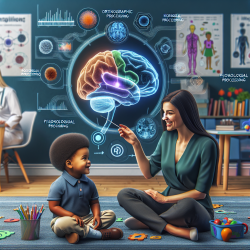Introduction
In the ever-evolving field of speech-language pathology, data-driven approaches are crucial for enhancing therapeutic outcomes. A recent study, "A neuroimaging dataset on orthographic, phonological and semantic word processing in school-aged children," provides valuable insights into how children process language. This blog explores how practitioners can leverage these findings to improve therapy strategies for children.
Understanding the Dataset
The study utilized functional magnetic resonance imaging (fMRI) to examine the neural mechanisms involved in orthographic, phonological, and semantic processing in children aged 8.7 to 15.5 years. The dataset includes data from 91 typically developing children, offering a comprehensive view of how these language components are processed in the brain.
The tasks involved rhyming, spelling, and semantic judgment, conducted in both auditory and visual modalities. This cross-sectional dataset allows for the exploration of developmental changes in reading skills, providing a rich resource for future research.
Key Findings and Implications for Practice
The study's findings highlight the distinct neural pathways involved in different aspects of language processing:
- Orthographic Processing: This involves the visual recognition of written words. The study found that orthographic processing engages specific brain regions, which are crucial for reading development. Practitioners can use this information to tailor interventions that enhance visual word recognition skills.
- Phonological Processing: This refers to the ability to recognize and manipulate sounds in language. The dataset reveals how phonological processing is critical for decoding words and suggests that interventions focusing on sound manipulation can be beneficial.
- Semantic Processing: Understanding word meanings and relationships is vital for language comprehension. The study's insights into semantic processing can inform strategies to improve vocabulary and comprehension skills in children.
Applying the Research in Therapy
Speech-language pathologists can apply these findings in various ways:
- Customized Interventions: By understanding the specific neural pathways involved in language processing, practitioners can design interventions that target the unique needs of each child.
- Multimodal Approaches: Incorporating both auditory and visual modalities in therapy can enhance learning and retention, as evidenced by the study's dual-modality tasks.
- Developmental Considerations: The cross-sectional nature of the dataset allows practitioners to consider developmental changes when planning interventions, ensuring that strategies are age-appropriate and effective.
Encouraging Further Research
While the current dataset provides a solid foundation, further research is essential to deepen our understanding of language processing in children. Practitioners are encouraged to explore additional datasets and studies to stay informed about the latest advancements in the field.
Conclusion
The insights from this neuroimaging study offer valuable guidance for speech-language pathologists aiming to enhance therapeutic outcomes for children. By incorporating these findings into practice, practitioners can create more effective, data-driven interventions that cater to the individual needs of each child.
To read the original research paper, please follow this link: A neuroimaging dataset on orthographic, phonological and semantic word processing in school-aged children.










